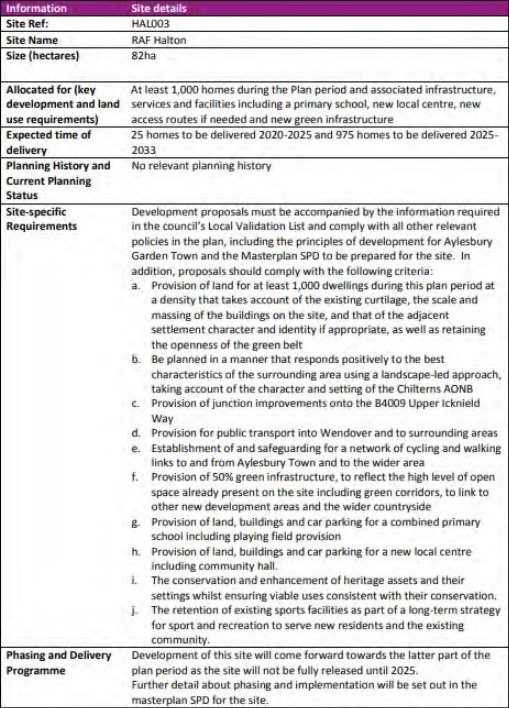RAF Halton SPD
Ended on the 4 March 2024
Appendices
Appendix 1: Relevant Vale of Aylesbury Local Plan policies
Policy S1 'Sustainable development for Aylesbury Vale', Policy S2, Spatial Strategy for Growth and Policy D-HAL003, RAF Halton, allocate the site for development.
Policy D-HAL003 is reproduced here in full:


Development proposals for the site will be assessed against the polices in the VALP, those of particular relevance include:
- Policy S5, Infrastructure: new development to provide infrastructure in accordance with the IDP; in planning for new development, appropriate regard will be given to existing deficiencies in services and infrastructure provision.
- PolicyS7,PreviouslyDevelopedLand:encourages the re-use of PDL in sustainable locations, subject to site -specific conditions and other policies.
- PolicyD1,DeliveringAylesburyGardenTown:sets out a series of principles for development within the Garden Town, including sustainable, high quality new communities
- Policy D2, Delivering site allocations in the rest of Aylesbury Vale
- Policy D7: Town, Village and Local centres to support new and existing communities
- PolicyH1,AffordableHousing:minimum requirement of 25% affordable homes – integrated throughout the site in accordance with the adopted SPD.
- Policy H5, Self/custom build housing: sites of 100 dwellings or more should provide a percentage of serviced plots to self/custom builders. Numbers to be determined site by site, according to demand, feasibility and subject to legal agreement.
- Policy H6a Housing Mix
- Policy H6c Accessibility
- Policy T1: Delivering the sustainable transport vision
- Policy T4: Capacity of the transport network to deliver development
- Policy T5: delivering transport in new development
- Policy T6: vehicle parking
- Policy T7: Footpaths and cycle routes
- Policy T8: electric vehicle parking
- Policy BE1, Heritage Assets: the historic environment will be preserved or enhanced. Where a development proposal is likely to affect a designated heritage asset and/or its setting negatively, the significance of the heritage asset must be fully assessed and supported in the submission of an application.
- PolicyBE2,Designofnewdevelopment:new development to respect and complement the physical characteristics of the site and surroundings; local distinctiveness and vernacular character of the locality; natural qualities and features of the locality; effect on public views and skylines. Policy refers to further guidance in the Design SPD.
- Policy BE3: Protection of the amenity of residents
- Policy BE4: Density of new development
- PolicyNE1,BiodiversityandGeodoversity:addresses treatment of protected sites; protection & enhancement of biodiversity and geodiversity – methodology for measuring biodiversity net gain to be set out in Bucks Biodiversity Accounting SPD.
- Policy NE3, the Chilterns AONB and setting: sets out requirements to be met for major development affecting the AONB – conserve and enhance the area's special qualities, distinctive character tranquillity and remoteness; avoid adverse impacts from individual proposals unless they can be mitigated. For developments within the AONB, they must meet the aims of the Chilterns AONB Management Plan and have regard to the Chilterns Building Design Guide. Requirements for a LVIA for development likely to impact on the AONB
- PolicyNE4Landscapecharacterandlocallyimportantlandscapes:development must recognise the individual character and distinctiveness of particular landscape character areas, as set out in the LCA, their sensitivity to change and contribution to a sense of place. Sets out criteria to consider when proposing development.
- Policy NE5: pollution, air quality and contaminated land
- PolicyNE8Trees,hedgerowsandwoodlands:requirement for a full tree survey as part of a planning application where trees in or adjacent to a site could be impacted.
- PolicyC3RenewableEnergy: development to seek greater efficiency in the use of natural resources.
- Policy C4: Protection of public rights of way
- Policy I1 Green Infrastructure: new developments of more than 10 dwellings required to meet the ANGST standards in Appendix C of the VALP to meet the need arising from the new development. formal outdoor sports areas, play areas and allotments should be located on land that is additional to the ANGST provided by a developer. All GI provided must have a long term management and maintenance strategy agreed by the council.
- PolicyI2SportsandRecreation: new development of >10 dwellings must meet the standards in Appendix D of the VALP. Any loss of existing sports and recreation facilities must meet a number of criteria. Need for a long term management and maintenance strategy to be agreed by the council. Formal sports areas should be separate to ANGST.
- PolicyI3Communityfacilities,infrastructureandassetsofcommunityvalue:consider the need for new community facilities and infrastructure to meet the need of new residents.
- Policy I4: Flooding
- Policy I5: Water resources and wastewater infrastructure
If you are having trouble using the system, please try our help guide.
Share on:





